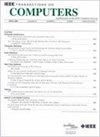A Multi-UAV Cooperative Task Scheduling in Dynamic Environments: Throughput Maximization
IF 3.6
2区 计算机科学
Q2 COMPUTER SCIENCE, HARDWARE & ARCHITECTURE
引用次数: 0
Abstract
Unmanned aerial vehicle (UAV) has been considered a promising technology for advancing terrestrial mobile computing in the dynamic environment. In this research field, throughput, the number of completed tasks and latency are critical evaluation indicators used to measure the efficiency of UAVs in existing studies. In this paper, we transform these metrics to a single optimization objective, i.e., throughput maximization. To maximize the throughput, we consider realizing this goal in two respects. The first is to adapt the formation of the UAVs to provide cooperative computing service in a dynamic environment, we integrate a policy-based gradient algorithm and the task factorization network as a new reinforcement learning algorithm to improve the cooperation of UAVs. The second is to optimize the association process between UAVs and users, where the heterogeneity of tasks is considered. This algorithm is modified from the Gale-Shapley stability concept to optimize the appropriate association between tasks and UAVs in a dynamic time-varying condition to get the near-optimal association with few iterations. The scheduling of dependent tasks and independent tasks jointly also has to be considered. Finally, simulation results demonstrate the improvement of cooperation performance and the practicability of the association process.求助全文
约1分钟内获得全文
求助全文
来源期刊

IEEE Transactions on Computers
工程技术-工程:电子与电气
CiteScore
6.60
自引率
5.40%
发文量
199
审稿时长
6.0 months
期刊介绍:
The IEEE Transactions on Computers is a monthly publication with a wide distribution to researchers, developers, technical managers, and educators in the computer field. It publishes papers on research in areas of current interest to the readers. These areas include, but are not limited to, the following: a) computer organizations and architectures; b) operating systems, software systems, and communication protocols; c) real-time systems and embedded systems; d) digital devices, computer components, and interconnection networks; e) specification, design, prototyping, and testing methods and tools; f) performance, fault tolerance, reliability, security, and testability; g) case studies and experimental and theoretical evaluations; and h) new and important applications and trends.
 求助内容:
求助内容: 应助结果提醒方式:
应助结果提醒方式:


